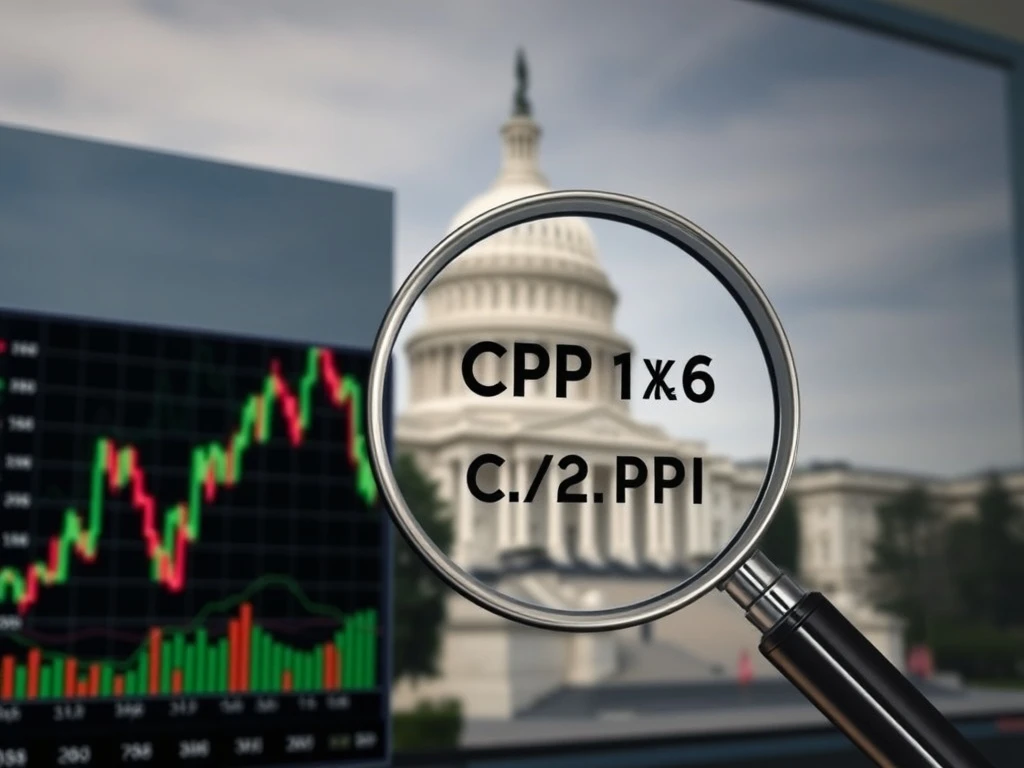The financial world holds its breath. US stock futures show little change as the market anticipates crucial inflation reports this week. Investors and analysts alike are keenly watching for fresh economic data. Specifically, the Consumer Price Index (CPI) and Producer Price Index (PPI) figures are due. These reports offer vital insights into the current state of inflation. Consequently, they often influence market sentiment and trading decisions.
Understanding US Stock Futures and Market Dynamics
First, let’s understand what US stock futures represent. These are agreements to buy or sell a specific stock index at a predetermined price on a future date. They act as a strong indicator for the broader market’s opening direction. Moreover, they reflect investor sentiment before the regular trading session begins. When futures are little changed, it suggests a wait-and-see approach among traders. They are holding off on major moves until new information emerges. This cautious stance often precedes significant economic announcements.
The market’s current stillness is quite telling. It highlights the significant impact inflation data now holds. High inflation erodes purchasing power. It also affects corporate profits. Therefore, investors carefully monitor inflation trends. They seek clues about the Federal Reserve’s next policy actions. Furthermore, interest rate decisions directly influence borrowing costs. This impacts everything from consumer loans to business investments. Thus, understanding these connections is crucial for any market participant.
The Significance of Upcoming Inflation Reports
Two primary inflation reports will capture market attention this week. These are the Consumer Price Index (CPI) and the Producer Price Index (PPI). Each provides a unique perspective on inflationary pressures. Together, they offer a comprehensive picture.
- Consumer Price Index (CPI): This report measures the average change over time in the prices paid by urban consumers for a market basket of consumer goods and services. It is a widely followed gauge of inflation. Moreover, it directly impacts household budgets.
- Producer Price Index (PPI): Conversely, the PPI measures the average change over time in the selling prices received by domestic producers for their output. This index reflects inflation from the perspective of producers. Changes here can eventually trickle down to consumer prices.
Economists scrutinize both headline and core inflation figures. Core inflation excludes volatile food and energy prices. This provides a clearer view of underlying price trends. Market participants will specifically look for any surprises. Unexpectedly high or low readings could trigger substantial market reactions. Therefore, traders prepare for potential volatility following these releases. Many investment strategies depend on these outcomes.
How Inflation Data Impacts US Stock Futures and Beyond
The release of inflation data carries significant weight for US stock futures and the broader economy. Here’s why:
- Federal Reserve Policy: The Federal Reserve closely watches inflation data. Their dual mandate includes achieving maximum employment and stable prices. Persistently high inflation could prompt the Fed to maintain higher interest rates. Conversely, cooling inflation might allow for rate cuts.
- Corporate Earnings: High inflation can squeeze corporate profit margins. Companies face increased costs for raw materials, labor, and transportation. This can reduce earnings forecasts. Lower earnings expectations often weigh on stock prices.
- Consumer Spending: Rising prices reduce consumers’ purchasing power. This can lead to decreased spending on non-essential goods and services. A slowdown in consumer spending impacts revenue for many businesses.
- Sectoral Performance: Certain sectors are more sensitive to inflation. For example, technology and growth stocks can be vulnerable to higher interest rates. Value stocks and commodities might perform better in inflationary environments.
Investors must consider these interconnected factors. Each piece of data contributes to the overall economic puzzle. Furthermore, market participants adjust their portfolios based on these evolving conditions. This dynamic environment requires constant vigilance.
Market Expectations and Potential Scenarios
Analysts currently anticipate specific outcomes for the upcoming inflation reports. However, deviations from these forecasts can lead to significant market shifts. Most economists expect a moderation in both CPI and PPI. Yet, the pace of this moderation remains a key unknown. A ‘hotter’ than expected report, indicating persistent inflation, could lead to market jitters. Investors might then anticipate a more hawkish stance from the Federal Reserve. This would likely push bond yields higher. Moreover, it could put downward pressure on US stock futures.
Conversely, a ‘cooler’ report, showing a faster decline in inflation, could spark optimism. Such an outcome might signal the Fed could ease monetary policy sooner. This scenario generally bodes well for equity markets. Lower interest rates typically boost corporate valuations. This encourages investment and consumer spending. Therefore, the market’s reaction will hinge on how the actual numbers compare to expectations. Unexpected results often lead to immediate and dramatic movements. This highlights the importance of precise data analysis.
Broader Economic Context and Global Influences
While domestic inflation reports are central, the broader economic context also plays a vital role. Global economic growth, geopolitical events, and commodity prices all influence market sentiment. For instance, supply chain disruptions originating overseas can impact domestic inflation. Similarly, global demand shifts affect commodity prices. These external factors can complicate the inflation picture. Therefore, analysts consider a wide range of inputs. This holistic view helps them forecast market movements. Investors also monitor international markets. Trends abroad can sometimes foreshadow domestic developments. Thus, a comprehensive understanding of global dynamics is essential for informed decision-making regarding US stock futures.
The current global economic landscape is complex. Various economies face their own inflationary challenges. Central banks worldwide are grappling with similar dilemmas. Their collective actions can have spillover effects. For example, a strong dollar, driven by US interest rate differentials, can impact multinational corporate earnings. This intricate web of global connections means no market exists in isolation. Therefore, a keen eye on international developments is always warranted.
Investor Sentiment and Risk Management
Investor sentiment remains a critical driver of market behavior. Currently, a sense of cautious optimism prevails. Many hope for a ‘soft landing’ for the economy. This implies inflation moderates without triggering a recession. However, the path to a soft landing is narrow. Any data point suggesting a deviation could quickly shift sentiment. Risk management becomes paramount in such an environment. Investors often employ strategies to mitigate potential losses. This includes diversification and hedging. They also carefully review their exposure to different asset classes. Managing risk effectively is key. It helps navigate periods of heightened uncertainty. Furthermore, patience is often rewarded. Rushing into decisions based on short-term news can be detrimental.
The upcoming inflation reports will test this sentiment. Traders will react swiftly to the numbers. Long-term investors, however, may look beyond immediate fluctuations. They focus on the underlying economic trends. Ultimately, the market seeks clarity. Clear signals on inflation’s trajectory will provide that. This will allow for more confident investment decisions. Until then, the focus remains squarely on the data. All eyes are on how these figures shape the future of US stock futures.
Looking Ahead: Beyond This Week’s Data
While this week’s inflation reports are crucial, the market’s focus extends beyond immediate data. Future economic releases, Federal Reserve speeches, and corporate earnings reports will continue to shape the outlook. Investors are constantly piecing together information. They are building a picture of the economic trajectory. The labor market, for example, remains a key indicator. Strong employment figures can support consumer spending. However, they can also contribute to wage inflation. Therefore, the interplay between various economic indicators is complex. It requires continuous analysis. Market participants must remain adaptable. They need to adjust strategies as new information emerges. This proactive approach helps navigate evolving market conditions. It ensures portfolios remain aligned with broader economic trends.
Moreover, geopolitical developments will continue to influence market dynamics. Conflicts, trade disputes, and policy shifts in major economies can all create ripples. These can impact everything from energy prices to supply chains. Consequently, a comprehensive market view requires attention to both micro and macro factors. The path forward for US stock futures will be shaped by a multitude of forces. This includes both domestic data and global events. Therefore, staying informed across all fronts is essential for success in today’s interconnected financial world.
Frequently Asked Questions (FAQs)
What are US stock futures?
US stock futures are financial contracts. They obligate a buyer or seller to transact a stock index at a predetermined price on a future date. They indicate how the broader market might open. They also reflect investor sentiment before regular trading begins.
Why are inflation reports important for the stock market?
Inflation reports, like CPI and PPI, are crucial because they directly influence Federal Reserve monetary policy. High inflation often leads to higher interest rates, which can negatively impact corporate earnings and stock valuations. Conversely, cooling inflation might lead to lower rates, boosting market optimism.
What is the difference between CPI and PPI?
The Consumer Price Index (CPI) measures changes in prices paid by consumers for goods and services. The Producer Price Index (PPI) measures changes in selling prices received by domestic producers for their output. CPI reflects consumer-level inflation, while PPI indicates producer-level inflation, which can eventually affect consumer prices.
How might the Federal Reserve react to the inflation reports?
The Federal Reserve uses inflation data to guide its interest rate decisions. If inflation remains high, the Fed might maintain or raise interest rates to cool the economy. If inflation shows signs of significant decline, the Fed might consider pausing rate hikes or even cutting rates in the future.
Should I adjust my investments based on these reports?
Short-term market reactions to inflation reports can be volatile. Long-term investors often focus on broader economic trends rather than reacting to single data points. However, understanding the potential impact helps in making informed decisions and managing risk. Always consult with a financial advisor for personalized advice.
























